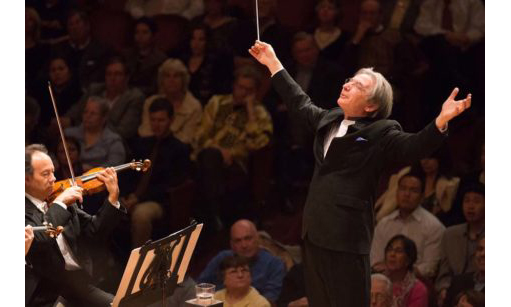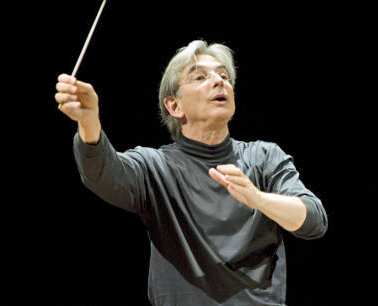
Michael Tilson Thomas leads atonal music with Philadelphia Orchestra, March 2017.
Contrast was stark in the concert which Michael Tilson Thomas led with the Philadelphia Orchestra the second week of March. The first half consisted of dissonant pieces from the 1930s — Ruth Crawford Seeger’s Andante for Strings and Alban Berg’s Violin Concerto, while the second half was devoted to Beethoven’s classic Symphony No. 3 (the Eroica).
Most of the audiences at Verizon Hall have scant interest in atonal music, but they put up with the Berg and Seeger because they respect Tilson Thomas. Their welcoming applause indicated that they have warm affection for the 72-year-old conductor. For years he was viewed as a junior version of Leonard Bernstein — intellectual, urban, Jewish, devoted to Mahler and Copland. Now he is recognized as a pioneer in his own right. He has encouraged innovative composers, helped them edit their scores, and conducted their works. He has hired diverse young players for the two orchestras he heads, the San Francisco Symphony and the New World Symphony in Miami.
As they gave their polite attention to Berg’s concerto, listeners may have, and should have, fallen under the spell of the lyric diatonicism of his 1935 composition. Berg used what’s known as the twelve-tone system and devised his own arrangement of twelve notes which were used repeatedly in sequence. That artifice bothered traditionalists, but Berg included a strong tonal undercurrent: the first three notes of the row make up a G minor triad, and his tone-row has other accessible chords.
To add intellectual appeal, the last four notes of Berg’s tone-row are also the first four notes of Bach’s chorale, Es ist genug (It Is Enough). What’s more, the notes that comprise chords from his tone-row spell the name “Bach.” The first half of the concerto rhythmically presents recurring passages that build to a climax, then the final part is a slow and calm adagio.
Even if all of that didn’t grab each listener, everyone had to be moved by the lovely, sunny final chord with which Berg said that everything was okay in the world. Tilson Thomas anticipated that chord with a slight pause that emphasized the change in mood. Bach’s cantata included the line “O Eternity, Thou Thunderous Word.” Unexpectedly, Berg died four months later at the age of 50.
The lanky, shaggy-haired Leonidas Kavakos gave meticulous attention to Berg’s violin writing, interacting closely with the orchestra.
 The opening piece by Seeger is barely known and is less than five minutes in length. It’s interesting, though, because it was written just four years before the Berg, and the composer used some of the same techniques. Seemingly opening with random notes, Seeger grouped them in her self-devised row and transformed them in color and volume til her composition reached a satisfying climax. She was an accomplished classical composer who married Charles Seeger, the collector of folk music who had a son from his first marriage, Pete Seeger. The composer always used her maiden name, Crawford, but the orchestra chose to bill her with her husband’s surname (possibly because it’s known to a wider public.)
The opening piece by Seeger is barely known and is less than five minutes in length. It’s interesting, though, because it was written just four years before the Berg, and the composer used some of the same techniques. Seemingly opening with random notes, Seeger grouped them in her self-devised row and transformed them in color and volume til her composition reached a satisfying climax. She was an accomplished classical composer who married Charles Seeger, the collector of folk music who had a son from his first marriage, Pete Seeger. The composer always used her maiden name, Crawford, but the orchestra chose to bill her with her husband’s surname (possibly because it’s known to a wider public.)
When it came to the Beethoven, MTT led an interpretation that was not at all like Bernstein, the man with whom he apprenticed. It was clear, crisp, understated in all movements except the second, the famous funeral march which is the emotional core of the symphony. There he brought out warm emotion. In this form, the Eroica seems like a logical progression from Beethoven’s Symphony No. 2, more so than a brother of his Fifth. That pounding drama was coming soon, but this Third was presented as a more restrained composition.
This review originally appeared in DC Metro Theater Arts